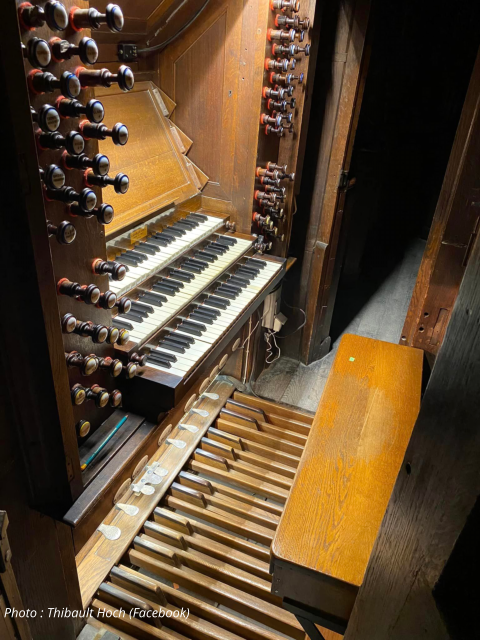


ORGUES DE PARIS © 2025 Vincent Hildebrandt ACCUEIL LES ORGUES
Cathédrale
Saint-Denis
Place de la Légion d'Honneur, 93200 Saint-DenisOrgue de tribune OdC >
1841 - Aristide Cavaillé-Coll1857 - Aristide Cavaillé-Coll
1901 - Charles Mutin
1987 - Danion-Dargassies & Boisseau-Cattiaux
2000 - Charles Sarelot
III/70 - traction mécanique - composition


La cathédrale Saint-Denis a été l'objet d'innovations
importantes à deux moments de son histoires
1.
En 1140, l'Abbé Suger décida d'agrandir la basilique
existante. Le résultat de cette décision est souvent
considéré comme le premier exemple d'architecture
gothique.
2.
En 1841, un nouvel orgue fut inauguré, fabriqué par
un jeune facteur d'orgue, Aristide Cavaillé-Coll
(1811-1899). D'un côté, il était dans la continuité de
la tradition des orgues fabriqués au cours des
siècles précédents par les dynasties de facteurs
comme les Thierry ou les Clicquot. Mais, d'un autre
côté, il présentait plusieurs innovations
révolutionnaires et très marquantes, qui formeront
la base des orgues symphoniques Français, ceux qui
domineront la seconde moitié du 19ème siècle.
L’e’glise
Sur les ruines d'un cimetière Gallo-Romain, une
première église avait été bâtie en 475 par Sainte
Geneviève, et une seconde, nettement plus grande,
au septième siècle par le Roi Dagobert Premier. Au
12ème siècle, l'Abbé Suger reconstruisit l'église
abbatiale, utilisant des spécificités très innovantes
sur le plan structural, mais aussi sur le plan décoratif,
spécificités qui lui avait été inspirées par certains
autres bâtiments existants. Il venait ainsi de créer le
premier édifice vraiment gothique.
En 1836, l'architecte François Debret dessina un nouveau
buffet, pour remplace le vieil orgue qui n'avait pas survécu à
la Révolution. Un concours fut organisé pour trouver le
facteur qui remplirait ce buffet, et plusieurs facteurs connus
de l'époque (Erard, Abbey, Dallery et Callinet) soumirent
leurs projets au jury. Quelques jours avant la fermeture des
dépôts de candidature pour le concours, un jeune facteur du
Sud de la France débarqua à Paris : il s'agissait d'Aristide
Cavaillé-Coll, alors âgé de 24 ans. Il avait entendu parler du
concours, et il se précipita sans attendre à Saint Denis. Il
travailla pendant deux jours sans interruption, et remit au
jury un projet supérieur aux autres, et surtout très
innovateur. Il gagna le concours, et cet événement peut être
considéré comme la naissance de la tradition des orgues
symphoniques français.
L’orgue fut inauguré en 1841, et présentait en effet plusieurs
innovations importantes :
- La boîte expressive du récit était actionnée par une pédale
à ressort (plus tard, ce sera une pédale à balancier)
- De nouveaux jeux firent leur apparition, imitant les
instruments de l'orchestre (basson, hautbois, clarinette). Une
flûte harmonique fut aussi ajoutée.
- Les sommiers étaient divisés en sections indépendantes,
avec des pressions de vent différentes pour les jeux de
fonds et les anches
- Une pédale fut ajoutée pour introduire ou annuler tous les
jeux d'anches d'un clavier.
- Il créa de nombreux jeux de fonds de 8 pieds.
- Il utilisa la machine pneumatique Barker, qui permettait
d'accoupler tous les claviers tout en continuant à jouer sans
fournir d'effort musculaire supplémentaire.
Toutes ces innovations permettaient d'obtenir un crescendo
du pianissimo au fortissimo tout en douceur, et sans a-coup
acoustiquement désagréables, ce qui n'était absolument pas
possible avant.
D'un autre côté, l'orgue était toujours très « classique », avec
un grand plein-jeu de 32 pieds, un clavier de Grand-Orgue
placé en seconde position, un pédalier classique à la
Française, avec un ravalement à partir du Fa, et un petit
clavier de récit.
En 1901, Charles Mutin entreprit des travaux de
restauration, et augmenta le nombre des jeux à 69. Le
pédalier fut étendu jusqu'au do, mais les notes entre le do
grave et le fa sont muettes, et ne parlent que lorsqu'elles
sont accouplées aux claviers.
En 1983-1987, l'orgue fut restauré par Danion / Dargassies
(pour les transmissions mécaniques) et par Boisseaux /
Cattiaux (pour l'harmonisation et les accords).
Le pédalier fut équipé d’une Barker mais la gambe et voix
céleste de Mutin furent supprimés.
Plus d’info
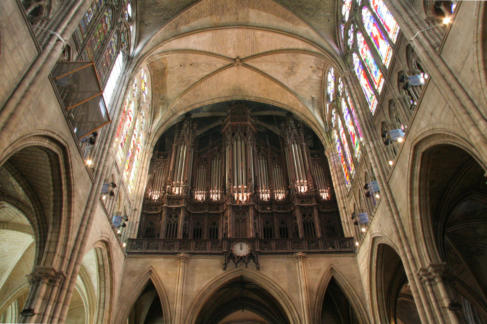
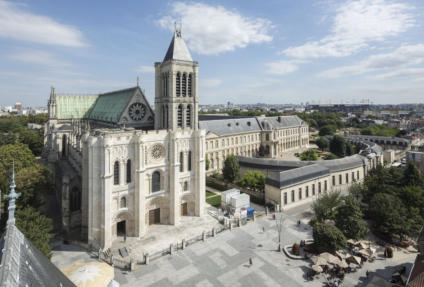
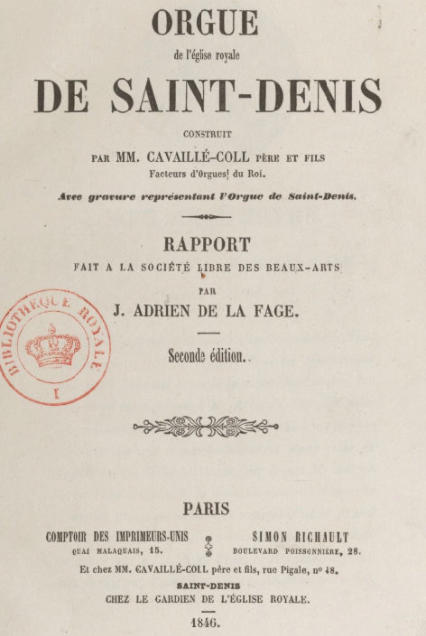
Organiste titulaire
Quentin Guérillot
Organistes célèbres du passé
Pierre Pincemaille (décédé le 12 janvier 2018)
Concerts
Régulièrement
Messes avec orgue
Samedi 18h30, Dimanche 11h15
Vidéo
Pierre Pincemaille
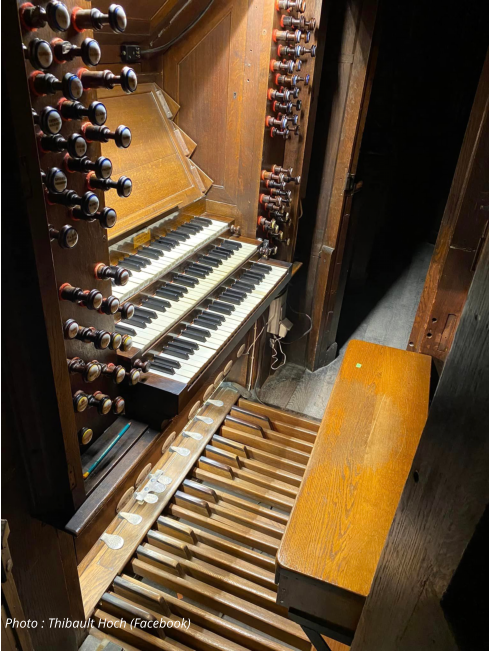

Les orgues de Paris
Cathédrale
Saint-Denis
Place de la Légion d'Honneur, 93200 Saint-DenisOrgue de tribune OdC >
1841 - Aristide Cavaillé-Coll1857 - Aristide Cavaillé-Coll
1901 - Charles Mutin
1987 - Danion-Dargassies & Boisseau-Cattiaux
2000 - Charles Sarelot
III/70 - traction mécanique - composition
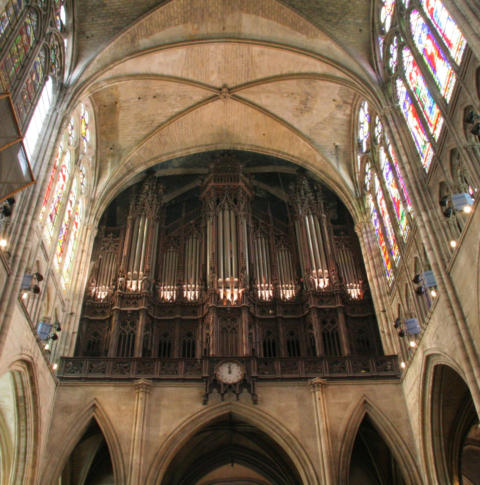
ORGUES DE PARIS © 2025 Vincent Hildebrandt LES ORGUES
En 1836, l'architecte François Debret dessina un nouveau
buffet, pour remplace le vieil orgue qui n'avait pas survécu à
la Révolution. Un concours fut organisé pour trouver le
facteur qui remplirait ce buffet, et plusieurs facteurs connus
de l'époque (Erard, Abbey, Dallery et Callinet) soumirent
leurs projets au jury. Quelques jours avant la fermeture des
dépôts de candidature pour le concours, un jeune facteur du
Sud de la France débarqua à Paris : il s'agissait d'Aristide
Cavaillé-Coll, alors âgé de 24 ans. Il avait entendu parler du
concours, et il se précipita sans attendre à Saint Denis. Il
travailla pendant deux jours sans interruption, et remit au
jury un projet supérieur aux autres, et surtout très
innovateur. Il gagna le concours, et cet événement peut être
considéré comme la naissance de la tradition des orgues
symphoniques français.
L’orgue fut inauguré en 1841, et présentait en effet plusieurs
innovations importantes :
- La boîte expressive du récit était actionnée par une pédale
à ressort (plus tard, ce sera une pédale à balancier)
- De nouveaux jeux firent leur apparition, imitant les
instruments de l'orchestre (basson, hautbois, clarinette). Une
flûte harmonique fut aussi ajoutée.
- Les sommiers étaient divisés en sections indépendantes,
avec des pressions de vent différentes pour les jeux de
fonds et les anches
- Une pédale fut ajoutée pour introduire ou annuler tous les
jeux d'anches d'un clavier.
- Il créa de nombreux jeux de fonds de 8 pieds.
- Il utilisa la machine pneumatique Barker, qui permettait
d'accoupler tous les claviers tout en continuant à jouer sans
fournir d'effort musculaire supplémentaire.
Toutes ces innovations permettaient d'obtenir un crescendo
du pianissimo au fortissimo tout en douceur, et sans a-coup
acoustiquement désagréables, ce qui n'était absolument pas
possible avant.
D'un autre côté, l'orgue était toujours très « classique », avec
un grand plein-jeu de 32 pieds, un clavier de Grand-Orgue
placé en seconde position, un pédalier classique à la
Française, avec un ravalement à partir du Fa, et un petit
clavier de récit.
En 1901, Charles Mutin entreprit des travaux de
restauration, et augmenta le nombre des jeux à 69. Le
pédalier fut étendu jusqu'au do, mais les notes entre le do
grave et le fa sont muettes, et ne parlent que lorsqu'elles
sont accouplées aux claviers.
En 1983-1987, l'orgue fut restauré par Danion / Dargassies
(pour les transmissions mécaniques) et par Boisseaux /
Cattiaux (pour l'harmonisation et les accords).
Le pédalier fut équipé d’une Barker mais la gambe et voix
céleste de Mutin furent supprimés.
Plus d’info
Organiste titulaire
Quentin Guérillot
Organistes célèbres du passé
Pierre Pincemaille (décédé le 12 janvier 2018)
Concerts
Régulièrement
Messes avec orgue
Samedi 18h30, Dimanche 11h15
Vidéo
Pierre Pincemaille
Photo buffet : Jeroen de Haan
